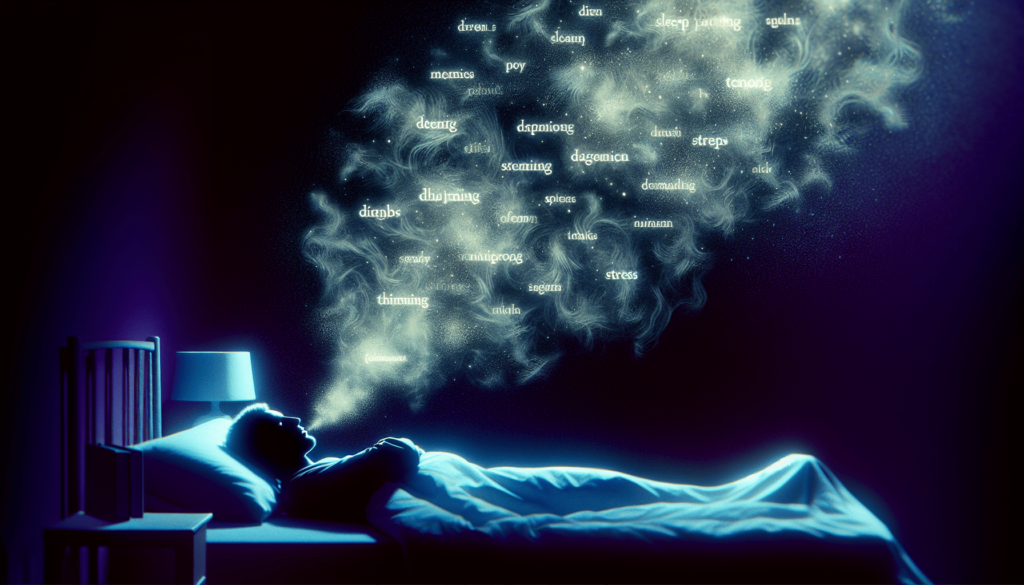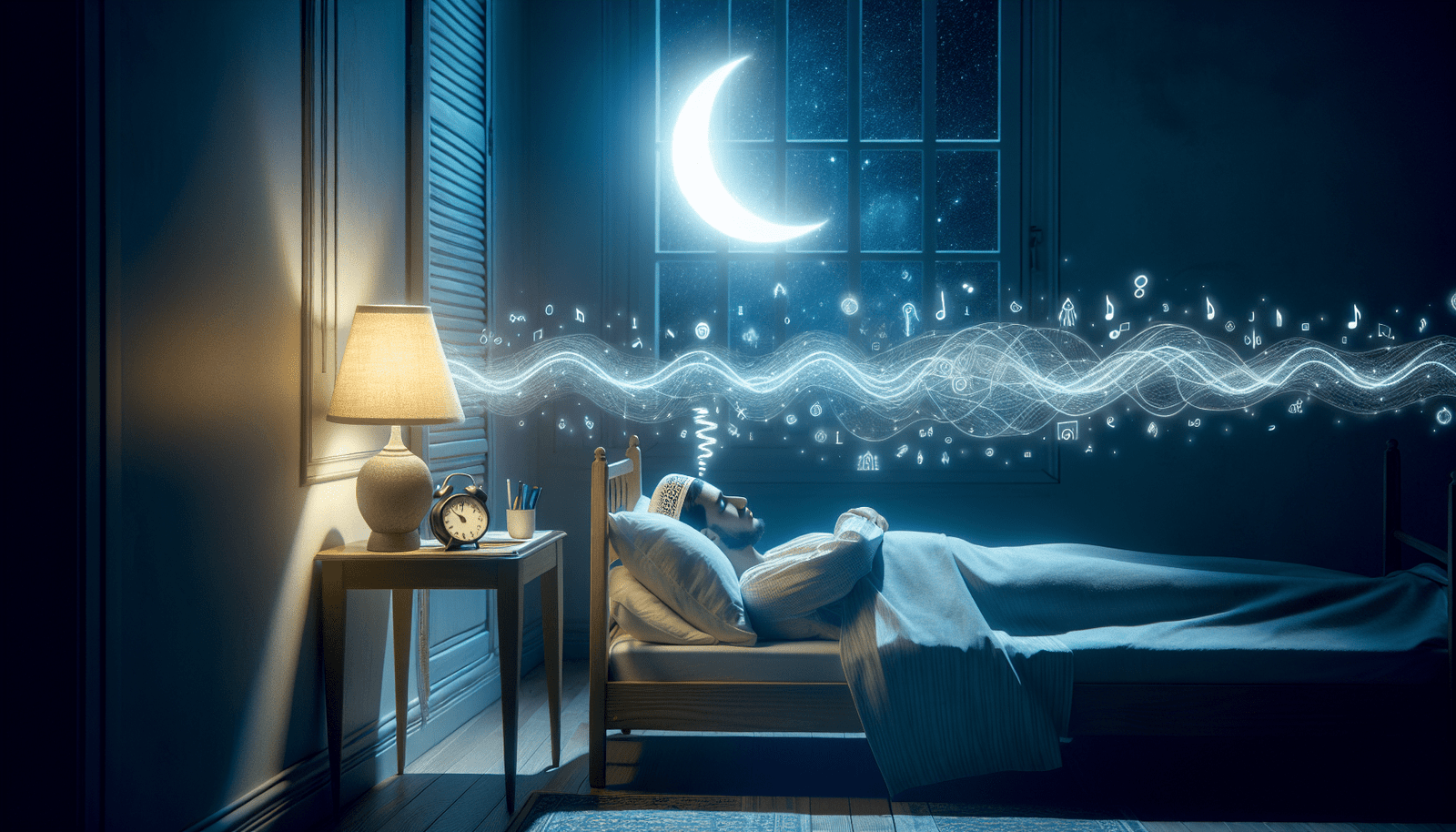Ever wondered why some people talk in their sleep? It turns out that this peculiar sleep behavior, known as sleep talking or somniloquy, is more common than you may think. While the exact cause is still not entirely understood, there are a few theories behind this fascinating phenomenon. From dreams and emotions to stress and sleep disorders, there are multiple factors that can contribute to someone’s late-night chatter. So, let’s unravel the mystery of why some people talk in their sleep, shall we?

Sleep Disorders
Introduction to Sleep Disorders
Sleep disorders are a common occurrence that can significantly impact a person’s quality of life. They encompass a range of conditions that disrupt the normal sleep patterns and result in various sleep-related disturbances. Among these sleep disorders, an intriguing phenomenon called sleep talking, also known as somniloquy, captures the curiosity of many.
Exploring Somniloquy
Somniloquy, or sleep talking, is a sleep disorder characterized by talking during sleep without the individual being aware of it. It can occur in various forms, including coherent sentences, mumbling, or even loud shouts. Sleep talking can happen during any stage of sleep, but it is most prevalent during the transition between wakefulness and sleep.
Types of Sleep Disorders
Sleep disorders can manifest in diverse ways, and sleep talking can be associated with several of them. Some common sleep disorders that may involve sleep talking include sleep apnea, sleepwalking, REM sleep behavior disorder (RBD), and night terrors. These conditions disrupt the sleep cycle and can lead to various sleep disturbances, including sleep talking.
Association between Sleep Disorders and Sleep Talking
Sleep talking is often seen as a symptom rather than a standalone disorder. It frequently coexists with other sleep disorders and tends to occur more frequently when these disorders are present. Researchers suggest that certain sleep disorders, such as RBD, have a stronger association with sleep talking compared to others. Understanding the relationship between sleep disorders and sleep talking can provide valuable insights into the underlying mechanisms.
Instances of Sleep Talking in Sleep Disorders
Sleep talking can manifest in different ways depending on the specific sleep disorder. For example, individuals with RBD may engage in vivid and often intense conversations or actions acting out their dreams during sleep. On the other hand, sleep talking in sleep apnea may occur due to the fragmented sleep and oxygen deprivation that often accompany the disorder. Exploring the instances of sleep talking within different sleep disorders can help shed light on the complexities of this phenomenon.
Sleep Stages and Brain Activity
Overview of Sleep Stages
To better comprehend sleep talking, it is crucial to understand the different stages of sleep. Sleep is divided into two main categories: rapid eye movement (REM) sleep and non-rapid eye movement (non-REM) sleep. Non-REM sleep consists of three stages: N1, N2, and N3. Each stage encompasses unique brain activity patterns and physiological changes.
REM Sleep and Dreams
During REM sleep, which is characterized by rapid eye movements, vivid dreaming occurs. This stage is associated with increased brain activity and heightened emotional experiences. While muscle tone is reduced during REM sleep to prevent acting out dreams, sleep talking can still occur during this stage.
Non-REM Sleep and Sleep Talking
Non-REM sleep, which consists of N1, N2, and N3 stages, is often considered a deeper and more restorative sleep. However, sleep talking can still take place during these stages. The content of sleep talking during non-REM sleep is usually less coherent and may consist of mumbled phrases or incomprehensible sounds.
Brain Activity during Sleep Talking
Research has shown that the brain exhibits different patterns of activity during sleep talking compared to wakefulness. During sleep, the brain’s frontal lobe, responsible for executive functions and conscious awareness, remains largely inactive. However, areas involved in language production, such as the Broca’s area, can still show some level of activity. These distinct brain activity patterns provide insights into the mechanism behind sleep talking.
Possible Causes of Sleep Talking
Genetic Factors
Genetic factors are believed to play a role in sleep talking. Studies have found that sleep talking can run in families, suggesting a genetic predisposition to the condition. Certain genetic variations may contribute to the susceptibility of an individual to engage in sleep talking.
Stress and Anxiety
Psychological factors, such as stress and anxiety, can contribute to sleep talking. Emotional distress can disrupt the normal sleep process and increase the likelihood of sleep talking episodes. Managing stress and implementing relaxation techniques may help reduce the frequency of sleep talking.
Sleep Deprivation
Lack of sufficient sleep or chronic sleep deprivation can trigger sleep talking. When the body and mind are exhausted, sleep becomes fragmented, leading to an increased likelihood of sleep disturbances like sleep talking. Prioritizing adequate sleep duration and maintaining a consistent sleep schedule may alleviate sleep deprivation-related sleep talking.
Alcohol or Drug Consumption
The consumption of alcohol or certain medications can intensify sleep talking episodes. These substances can disrupt the sleep cycle and affect the brain’s activity during sleep, increasing the likelihood of engaging in sleep talking. Avoiding alcohol or drugs close to bedtime may help minimize sleep talking occurrences.
Sleep-Related Eating Disorders
Sleep-related eating disorders, such as sleep-related eating disorder (SRED) and nocturnal eating syndrome (NES), have been associated with sleep talking. These disorders involve abnormal eating behavior during sleep, which may occur alongside sleep talking episodes. Proper diagnosis and treatment of sleep-related eating disorders may help alleviate sleep talking symptoms.
Underlying Sleep Disorders
As mentioned earlier, sleep talking often coexists with other sleep disorders, such as sleep apnea, RBD, and night terrors. Treating the underlying sleep disorder can help reduce the occurrence of sleep talking episodes. Identifying and addressing the root cause of sleep talking is crucial for effective management.
Medical Conditions and Medications
Certain medical conditions, such as fever, sleep deprivation, or psychiatric disorders, can contribute to sleep talking. Additionally, certain medications, such as benzodiazepines or antidepressants, may increase the likelihood of sleep talking as a side effect. Consultation with a healthcare professional can help determine if any underlying medical conditions or medications may be contributing to sleep talking.
Childhood Development and Sleep Talking
Sleep talking is more prevalent in children compared to adults. It is common during childhood and often resolves naturally as the child grows older. The exact cause of sleep talking in children is not fully understood, but factors such as immature nervous system development, stress, or other sleep disorders may contribute to its occurrence.
Other Potential Triggers
Several other factors can potentially trigger sleep talking. These include fever, sleep inertia (grogginess upon awakening), sleep-related movement disorders, and even certain sleep environments. Identifying these triggers can be challenging; however, understanding their potential role may provide additional strategies for managing sleep talking.

The Role of Age and Gender
Age and Sleep Talking
Sleep talking is most prevalent in children and adolescents, with the frequency gradually decreasing as individuals reach adulthood. While it may persist in some adults, it is generally less frequent and intense compared to childhood. The exact reasons for this age-related decline in sleep talking are not yet fully understood, but hormonal changes, brain development, and overall changes in sleep patterns may contribute to this phenomenon.
Gender Differences in Sleep Talking
Research has suggested that there may be slight gender differences in sleep talking. Some studies have found that males tend to engage in sleep talking more frequently than females. However, the exact reasons for this difference remain unclear. Hormonal factors, societal influences, and variations in sleep architecture may play a role in the gender differences observed.
Associated Risks and Complications
Embarrassment and Social Impact
Sleep talking can often be embarrassing for the individual experiencing it, especially if it occurs in the presence of others. The potential for saying things that are inappropriate or personal can lead to feelings of discomfort or shame. This can impact one’s self-esteem and social interactions, making it important to address any emotional implications associated with sleep talking.
Disturbed Sleep Patterns
Sleep talking can disrupt both the sleep of the individual experiencing it and that of their bed partner. Frequent episodes of sleep talking can result in fragmented sleep, leading to daytime fatigue and reduced overall sleep quality. Addressing the underlying causes of sleep talking can help improve sleep patterns for both the individual and their bed partner.
Sleep-Related Injuries
In certain cases, sleep talking can lead to sleep-related injuries. Individuals may talk or shout loudly during sleep, potentially causing them to knock objects over or even fall out of bed. This can result in physical harm, such as bruises, cuts, or sprains. Taking necessary measures to create a safe sleep environment is crucial to minimize the risk of sleep-related injuries.
Negative Impact on Bed Partner’s Sleep
Sleep talking can significantly affect the sleep of a bed partner. The loud or disruptive nature of sleep talking can lead to disturbances and awakenings, making it difficult for the bed partner to get restful sleep. Open communication and seeking professional assistance may help both individuals navigate the challenges associated with sleep talking.
Indication of Other Underlying Problems
Sleep talking can sometimes be a manifestation of underlying medical or psychological conditions. It can serve as a potential indicator of other sleep disorders, including sleep apnea, RBD, or night terrors. Recognizing sleep talking as a potential symptom and seeking appropriate evaluation can help identify and address any underlying problems.
Diagnosis and Evaluation
Self-Observation and Sleep Diary
If you suspect you or someone you know is experiencing sleep talking, keeping a sleep diary can be a helpful tool. Recording the frequency, intensity, and content of sleep talking episodes can provide valuable information for discussion with a healthcare professional. Observing any potential triggers or patterns associated with sleep talking can also aid in the diagnostic process.
Sleep Studies and Polysomnography
For a comprehensive evaluation of sleep talking, a sleep study or polysomnography may be recommended. These tests monitor various physiological parameters during sleep, including brain activity, eye movements, muscle tone, and respiratory function. This objective data helps identify any underlying sleep disorders or disturbances that may be contributing to sleep talking.
Consultation with a Sleep Specialist
Consulting with a sleep specialist is crucial for accurate diagnosis and appropriate treatment. Sleep specialists are trained to recognize and evaluate sleep disorders, including sleep talking. They can perform a thorough assessment, consider individual circumstances, and provide tailored recommendations or interventions based on their expertise.
Identifying Underlying Conditions
Once a diagnosis of sleep talking is established, it is essential to identify any underlying conditions that may be contributing to its occurrence. This may involve additional assessments or consultations with other healthcare professionals, such as psychologists or otolaryngologists, to evaluate potential psychological or physiological factors.
Treatment and Management
No Intervention Required
In some cases, sleep talking may not require any intervention. If sleep talking does not disrupt the individual’s sleep or cause significant distress, it may be considered a harmless quirk that does not necessitate treatment. However, if sleep talking is causing distress, disturbing sleep patterns, or negatively impacting the individual’s well-being or relationships, management strategies may be beneficial.
Improving Sleep Hygiene
Maintaining good sleep hygiene can be an effective way to manage sleep talking. This includes establishing a consistent sleep schedule, creating a comfortable sleep environment, avoiding stimulating activities close to bedtime, limiting caffeine and alcohol intake, and implementing relaxation techniques before sleep. These practices promote healthy sleep and reduce the likelihood of sleep disturbances.
Stress and Anxiety Management Techniques
Given the potential link between stress, anxiety, and sleep talking, implementing stress and anxiety management techniques can be beneficial. Engaging in activities such as meditation, deep breathing exercises, or engaging in stress-reducing hobbies can help alleviate the emotional burden associated with sleep talking.
Addressing Sleep Disorders
If sleep talking is a symptom of an underlying sleep disorder, such as sleep apnea or RBD, managing the primary condition can help reduce the occurrence of sleep talking episodes. Treatment options may include continuous positive airway pressure (CPAP) for sleep apnea or medication for RBD. Consultation with a sleep specialist is essential for proper diagnosis and appropriate management.
Medication and Therapy
In certain cases, medication or therapy may be recommended to address sleep talking. Medications, such as benzodiazepines or antidepressants, may help reduce sleep talking episodes in some individuals. Additionally, cognitive-behavioral therapy (CBT) or counseling can be beneficial in managing any underlying psychological factors contributing to sleep talking.
Communication and Support
Open communication and support from family members or bed partners can greatly assist individuals dealing with sleep talking. By understanding the condition and discussing concerns or potential triggers, loved ones can provide a supportive environment. Mutual support and understanding can help alleviate stress and improve overall well-being.
Tips for Bed Partners
Understanding the Condition
For bed partners of individuals experiencing sleep talking, understanding the condition is essential. Educating oneself about sleep disorders and the potential triggers for sleep talking can facilitate empathy and create a compassionate environment. Knowing that sleep talking is often involuntary and not a reflection of the individual’s true thoughts or emotions can help alleviate any concerns.
Creating a Comfortable Sleep Environment
Creating a comfortable sleep environment is crucial for both the individual experiencing sleep talking and their bed partner. Minimizing noise disturbances, implementing soothing bedtime routines, and ensuring a relaxing sleep environment can help promote quality sleep for both individuals. Using earplugs or seeking alternative sleeping arrangements if necessary can also be considered.
Reacting Appropriately
If a bed partner is awakened or disturbed by sleep talking, it is important to react appropriately. Remaining calm and reassuring can help the individual return to sleep more easily. Avoiding confrontations or attempting to engage in conversation during sleep talking episodes is usually the best approach.
Seeking Professional Assistance
If sleep talking becomes a consistent or distressing issue for both the individual and their bed partner, seeking professional assistance is recommended. Consulting with a sleep specialist or healthcare professional can provide expert guidance and appropriate management strategies for addressing sleep talking.
Supporting the Sleep-Talking Individual
Supporting the individual experiencing sleep talking can make a significant difference in their overall well-being. Providing a nonjudgmental and understanding attitude can alleviate any embarrassment or anxiety associated with sleep talking. Encouraging the individual to seek proper evaluation and treatment, if required, can also be beneficial.
Fascinating Sleep-Talking Stories
Unusual Sleep Conversations
Sleep talking can lead to some truly peculiar and even hilarious conversations. From discussing nonsensical topics to engaging in imaginative dialogues, the content of sleep talking can be surprising and entertaining. Capturing these unusual conversations can provide a unique perspective on the mysteries of the subconscious mind.
Funny and Embarrassing Moments
Sometimes sleep talking can result in embarrassing or funny situations. Individuals may reveal embarrassing secrets or engage in comical exchanges, much to their own surprise upon awakening. Sharing these lighthearted moments can highlight the quirks of sleep talking and provide a source of amusement.
Historical Accounts of Sleep Talking
Throughout history, sleep talking has been an intriguing subject, often documented in various historical accounts. Reports of prominent figures engaging in sleep talking, from poets to politicians, highlight the universality of this phenomenon. Exploring these historical accounts can offer glimpses into the prevalence of sleep talking throughout different cultures and time periods.
Celebrities and Sleep Talking
Even celebrities are not immune to sleep talking. Famous individuals have shared their experiences of talking in their sleep, providing entertaining anecdotes and humanizing their larger-than-life personas. These stories serve as a reminder that sleep talking is a common occurrence that transcends societal distinctions.
Conclusion
Sleep talking, or somniloquy, is a fascinating sleep disorder that continues to intrigue researchers and individuals alike. Understanding the causes, associated risks, and available treatment options is crucial for managing this condition effectively. By embracing the quirkiness of sleep talking and seeking appropriate support and intervention when necessary, individuals can navigate the complexities of this phenomenon and improve their overall sleep quality and well-being.
